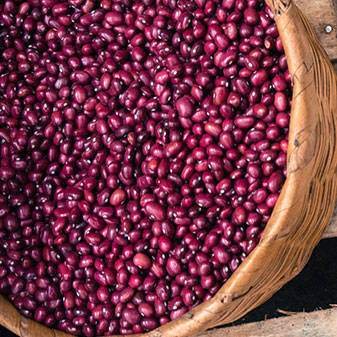Cooking with Beans - preparation and uses of dried beans & pulses
3 Steps to Cooking With Dried Beans and Pulses
Nutritious and versatile, dried beans and pulses are easier to cook than you might think. You’ll love the creamy texture

and low price that canned beans can’t match. Whether you crave chilli or split pea soup, you’ll want to keep dried beans and pulses on hand.
1. Sort and Soak
It’s important to soak dried beans and pulses in water for eight hours or overnight before you cook them. This process shortens the cooking time and makes the beans easier to digest. Lentils and split peas, however, do not require soaking.
Before soaking, pour the dried beans into a bowl and remove debris such as pebbles, dried soil, or damaged beans. Then, place the beans in a strainer and rinse thoroughly. Transfer the beans to a large pot or bowl and cover with water. Beans or pulses expand as they soak, so be sure the pot or bowl is big enough.
If you don’t have time or forget to soak overnight, a quick soak is just the ticket. Place the dry beans in a large pot and cover with water. Bring the water to a boil, cover the pot, and remove from heat. Let the beans stand for an hour.
2. Simmer the Beans or Pulses
After soaking, pour the beans into a strainer and rinse thoroughly. Place the beans into another large pot and cover with two or three inches of water. The beans will increase in size with cooking, so be sure to add enough water.
Cook the beans at a gentle simmer. To prevent a mushy texture, do not allow the water to boil. Add a very light amount of salt at this time, since too much salt at this stage can result in tough beans.
3. Add Flavour and Finish Cooking
Now you can be creative and add your favourite herbs and aromatics to the beans or pulses. Onions, garlic, bay leaves, and sage are just a few possibilities. Do not add more salt or acidic ingredients, such as tomatoes, until the beans have finished cooking. Like salt, acidic ingredients will create tough beans when added too early.
Simmer until the beans are tender enough to eat. Cooking times will vary, depending on the specific bean. For example, pinto beans can simmer for 90 minutes, while lentils and split peas need 30 to 40 minutes.
When the beans have finished cooking, add as much salt and acidic ingredients as you like. Let the beans or pulses stand in their broth for 30 minutes to absorb the flavours. Enjoy your beans or pulses!
References
How to Cook Dried Beans
Cooking With Pulses
Preparing Beans in Advance
